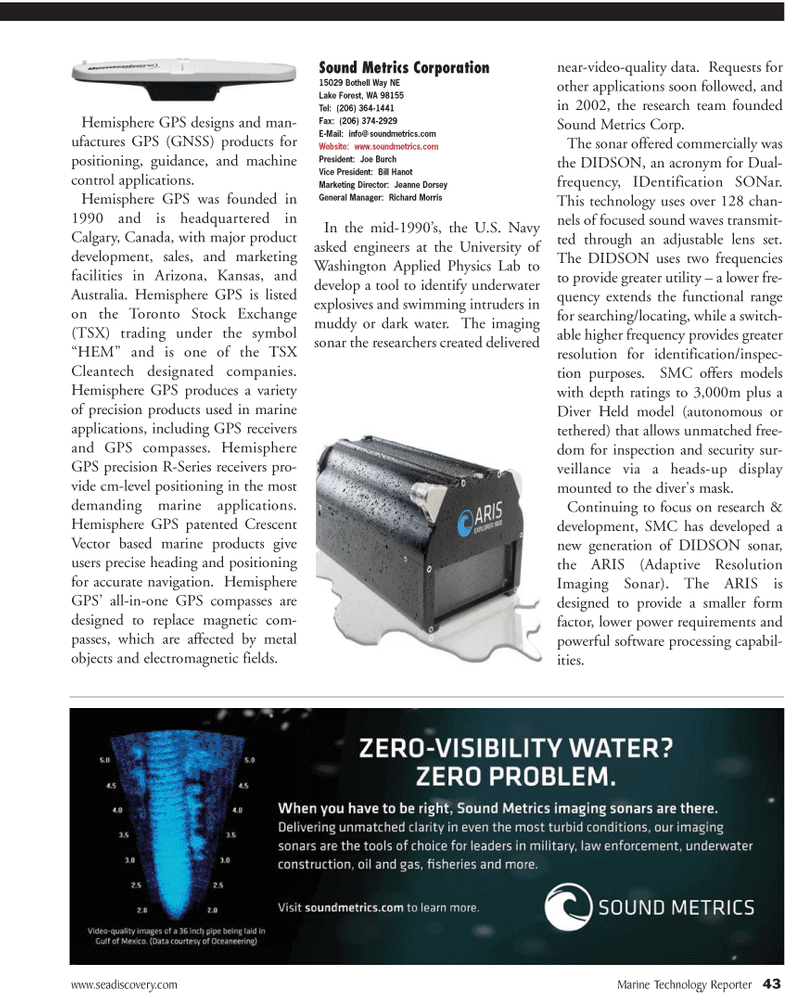
Page 43: of Marine Technology Magazine (July 2011)
MTR100 Edition
Read this page in Pdf, Flash or Html5 edition of July 2011 Marine Technology Magazine
www.seadiscovery.com Marine Technology Reporter 43Hemisphere GPS designs and man- ufactures GPS (GNSS) products for positioning, guidance, and machinecontrol applications. Hemisphere GPS was founded in 1990 and is headquartered in Calgary, Canada, with major product development, sales, and marketing facilities in Arizona, Kansas, and Australia. Hemisphere GPS is listed on the Toronto Stock Exchange (TSX) trading under the symbol HEM? and is one of the TSX Cleantech designated companies.Hemisphere GPS produces a variety of precision products used in marine applications, including GPS receivers and GPS compasses. Hemisphere GPS precision R-Series receivers pro- vide cm-level positioning in the most demanding marine applications.Hemisphere GPS patented Crescent Vector based marine products give users precise heading and positioning for accurate navigation. Hemisphere GPS all-in-one GPS compasses are designed to replace magnetic com- passes, which are affected by metal objects and electromagnetic fields. Sound Metrics Corporation 15029 Bothell Way NE Lake Forest, WA 98155 Tel: (206) 364-1441 Fax: (206) 374-2929 E-Mail: info@ soundmetrics.com Website: www.soundmetrics.com President: Joe Burch Vice President: Bill Hanot Marketing Director: Jeanne Dorsey General Manager: Richard Morris In the mid-1990s, the U.S. Navy asked engineers at the University of Washington Applied Physics Lab to develop a tool to identify underwater explosives and swimming intruders in muddy or dark water. The imaging sonar the researchers created delivered near-video-quality data. Requests for other applications soon followed, and in 2002, the research team founded Sound Metrics Corp. The sonar offered commercially was the DIDSON, an acronym for Dual- frequency, IDentification SONar. This technology uses over 128 chan- nels of focused sound waves transmit- ted through an adjustable lens set. The DIDSON uses two frequencies to provide greater utility ? a lower fre- quency extends the functional rangefor searching/locating, while a switch- able higher frequency provides greater resolution for identification/inspec- tion purposes. SMC offers models with depth ratings to 3,000m plus aDiver Held model (autonomous or tethered) that allows unmatched free- dom for inspection and security sur-veillance via a heads-up display mounted to the diver's mask. Continuing to focus on research & development, SMC has developed a new generation of DIDSON sonar, the ARIS (Adaptive Resolution Imaging Sonar). The ARIS is designed to provide a smaller form factor, lower power requirements and powerful software processing capabil- ities.

 42
42

 44
44
